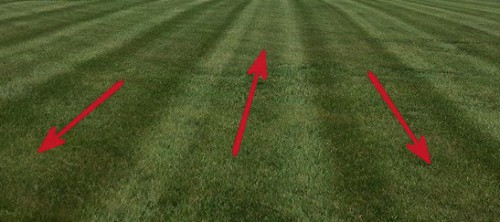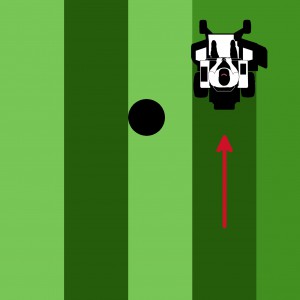Lawn striping tips: Mowing patterns and equipment
Posted on:Jun 21, 2014
 Photo courtesy of Christopher's Lawn & Landscape in Kearney, Mo.
Photo courtesy of Christopher's Lawn & Landscape in Kearney, Mo.
You don't need a PhD in horticulture or experience on an MLB grounds crew to do lawn striping right. With the correct approach and the right equipment, you can stripe any lawn. But, before you can give your backyard the "big-league" look, you need to know how lawn striping works.
How does lawn striping work?
Lawn striping is done by bending grass and using light and shadows to create alternating light-dark stripes in the lawn. Sections bent away from you reflect light and appear as lighter green strips. Sections bent toward you reveal shadows under the blades and appear as darker green strips.
"Darker" strips are bent toward you while "lighter" strips are bent away from you.
Mowing heights for perfect lawn striping
A taller mowing height allows the grass to bend easier and enhances the striping effect. The general rule of thumb is to mow between 2.5 and 3.5 inches for best results. While it's possible to stripe warm-season grasses like Bermuda and St. Augustine, the plants are rigid and do not bend as easily. In addition, these species are typically maintained at shorter heights, which also makes striping more difficult.
Cool-season varieties  like fescue and bluegrass  generally provide the most dramatic lawn striping patterns. These plants bend easier and are healthier overall when mowed taller.
Lawn striping patterns, terrain and obstacles
Mow a one-mower-width perimeter first, then mow alternating directions across the lawn to create the striping pattern. Pick a stationary object in the distance and fix your eyes on it as you mow. This will help you keep the stripes straight across the lawn. Overlap each pass -- a good rule of thumb is 10 percent (example: 6" overlap for 61" deck) -- so you don't leave any uncut strips.
Mow around obstacles on the uncut side so that the next pass will cover the turn and maintain the overall pattern.
Switch the mowing pattern regularly to prevent the grass from "learning" to grow a certain way. This is hard on the plant and makes changing the pattern harder in the future. Not only that, but some patterns will work better than others for a particular landscape. Don't be afraid to get creative to see what lawn striping patterns make your yard the talk of the neighborhood.
Choosing the right lawn striping equipment
Zero-turn mowers are the most efficient and least exhaustive equipment for lawn striping and mowing patterns. Maneuvering in opposite directions and around obstacles is easier and takes less time with a ZTR mower than a traditional steering wheel mower.
Some zero turn mowers require lawn striping kits to bend and smooth the grass. Striping kits are useful for more complex patterns, like making team logos appear in the outfield of a major-league ballpark.
But lawn striping is a standard feature on a Grasshopper zero-turn mower. All Grasshopper DuraMax® mowing decks are equipped with a heavy-duty rear deck flap that bends the grass after it's cut, creating the effect without the need for an additional, costly striping kit.
Want proof? Check out this photo album dedicated to Grasshopper mowers striping lawns across America!
Mowing patterns in your lawn can be easy with the right techniques and the right equipment. Not only that, it's a great way to add curb appeal to your property and accentuate different focal points in your landscape. And, it can be simply beautiful to look at.




